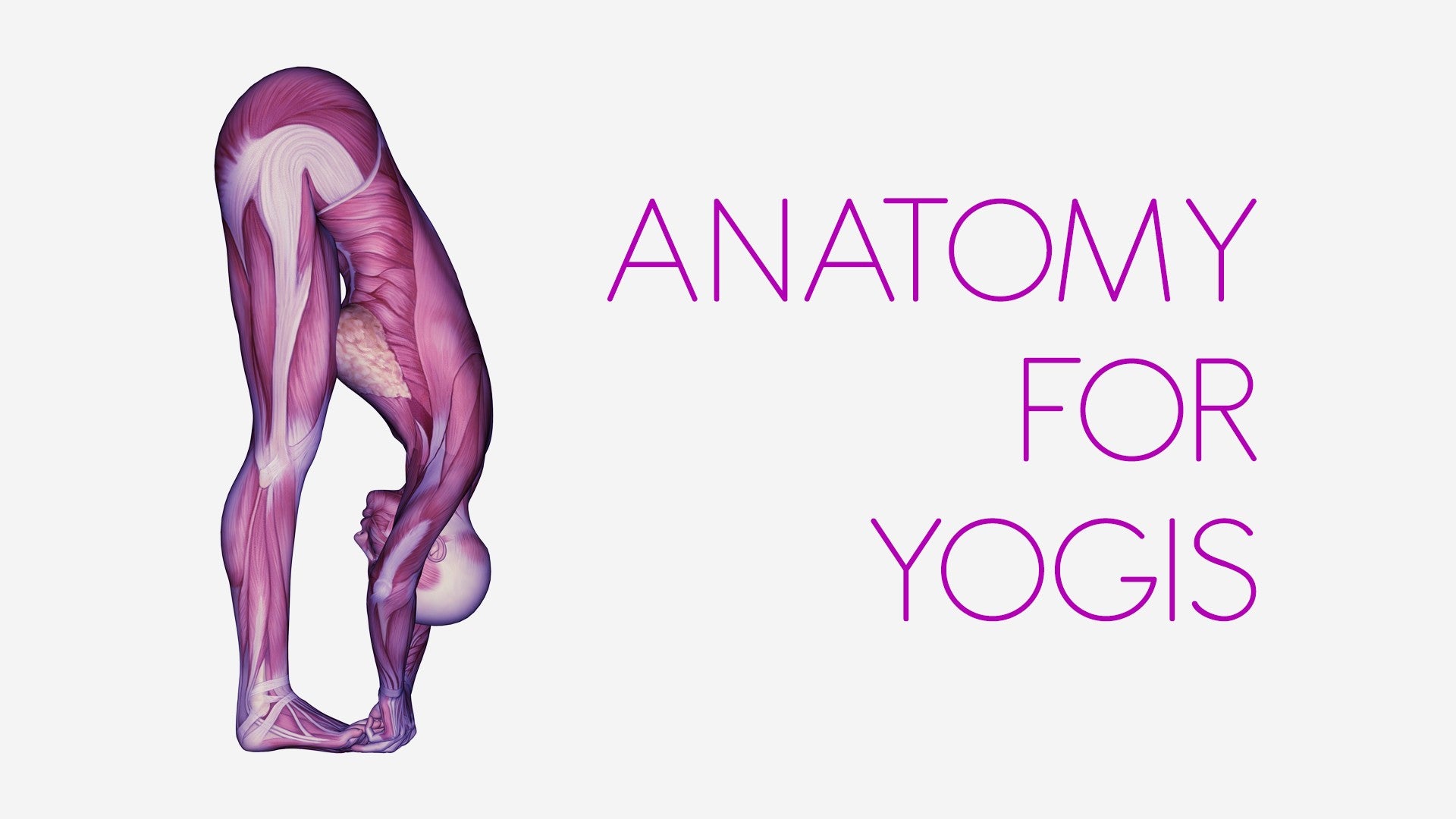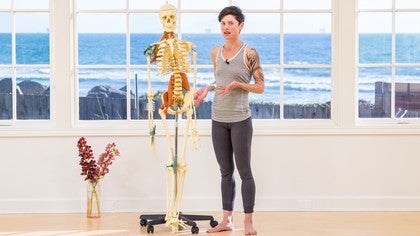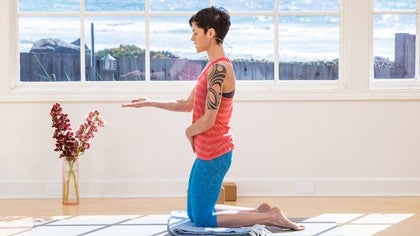Description
About This Video
Transcript
Read Full Transcript
Hello and welcome. I wanted to take this time just to talk a little bit about hypermobility. I reference it a number of times in the practice sequences that I lead and I'm really interested in reaching out to people who are hypermobile because I feel like we, you all and myself included, are a population that sometimes actually gets overlooked in yoga. In general I think that bodies typically are a little tighter and more well held together and so in classes a lot of teachers are cueing to students who are experiencing tightness and stiffness and in fact that's a really wonderful reason to practice yoga. However, those of us who are hypermobile probably have found our way into yoga classes and many of us have been given the feedback that we're good at yoga because we're flexible and if you like me found yourself in that situation and then continued to practice in such a way that really kind of pushed in or might even say exploited your flexibility, it's good to know that there are ways to practice that honor your body that aren't actually about seeking out a stretch sensation and that take into consideration the unique and potentially dangerous opportunities or options that your body presents you with. So hypermobility is a thing. It's a real thing. It's when there's too much laxity in your joints. If you wonder if you're hypermobile, if you think that you might be, there's actually a score called the beaten score. That's B-E-I-G-H-T-O-N. And it's just a really simple test of capability of what your body can do and if you score beyond a certain point you're considered hypermobile. So as I said, hypermobility is too much laxity in your joints. It's probably genetic. It can range anywhere from mild and unnoticeable to severe and actually really threatening to someone's health. If you're severely hypermobile and it's affecting your health, you probably know about it and you're probably not practicing yoga that pushes into your flexibility even more because it doesn't feel safe. However, if you're at the lower end of the spectrum, you might not even be aware that when you're stretching, you're doing damage to your body rather than good. So for those of us that are hypermobile, we need to be aware that in classes that are emphasizing stretch sensation and opening through postures that we're actually doing something else. And this is something that I've learned over years of listening to teachers and knowing that they're probably not cueing to me. When you're hypermobile, actually I'll just speak for myself, as a hypermobile person, I've noticed that I often don't really have a sense of where I am in space. So because I have so many options and I can do so many different things with my body, I sometimes don't even really know where I am. And if you're a teacher, you know the hypermobile students because they go so far into postures and it's actually surprising to them when you ask them to lift up a little bit out of their flexibility. So as teachers and as practitioners, we need to be aware that sometimes there is not even sensation as a cue to tell us when we've gone too far. So number one to practice if you're hypermobile is actually to get a couple of good anatomy books and check out pictures of joints and see what joint capsules look like. So joint capsules are connective tissue webbing, continuous with ligaments, tendons, and the small intrinsic muscles that wrap around a joint for stability. We want to maintain integrity of the joint capsule and not push past it too much. The type of tissue this is isn't super elastic. If you over stretch it, it might never go back to its original shape. So it's really important that you become aware of where your joints are, what kind of shape they are, and what a healthy range of movement is. And then practice with a mirror, practice with videos, and practice with friends who can help you learn where the healthy and appropriate boundaries are because you might actually not even be able to feel it. Unfortunately, if you spend a lot of time overstretching, at some point you will feel it. And those of us that are hypermobile run the risk of developing arthritis later in life and other joint problems. So it's definitely worth it, especially if you're younger and at the beginning of your practice, to take note of the potential pitfalls of pushing all the way to the edge of your flexibility. You really want to maintain the health and integrity of your joints. Along with the physical aspects of hypermobility, I found that there's a really similar kind of emotional or energetic correspondence to being hypermobile. So literally sometimes I don't know my own boundary. Energetically I find this by being really porous, kind of taking on other people's energy a lot or feeling like I can just go and go and go and go. There's actually research coming out now that links hypermobility with a body tendency to overproduce adrenaline. Crazy. So for those of us that are hypermobile, we also need to be aware of what our energetic output is, that we're not pushing past our own boundaries. This is something that you develop over time with the help of your trusted friends, colleagues, therapists, figuring out when it's appropriate to say no to things, when you need to stop and rest, when you need to give yourself more care. Another important part of practice if you're human, but especially if you're dealing with hypermobility, is to give yourself enough time to rest. So connective tissue isn't just in your joints, it's also in your organs. So the same kind of fibers that make your joints are also part of what make your organs. And in order for the organs to be strong, we need to have enough rest. If you're a person who is really bendy and flexible and you're approaching a yoga practice in a more competitive way, this is especially important that you take the time to rest, that you do restorative postures and give yourself compression. So again, just this sense of knowing where your boundaries are and feeling that there is kind of resistance and support. I found a lot of healing happen in my own body from spending time lying on my belly or having pressure on my belly. So pressure on the belly is linked to stimulation of your parasympathetic nervous system. That's the part of your nervous system that innervates your organs and it's what keeps your vital functions functional and healthy. And time on your belly is also linked to literally to your strength. So when babies are little, they spend a lot of time on their belly so that they can learn to push up from the floor. So for a lot of us that are kind of like loosey-goosey in our limbs, actually spending time with compression on the belly can be really helpful to start to develop this deep flexor tone or flexor strength. In the practices that I guide, I go through a lot of different strengthening for different joints in the body for more of a global or integrated core balance. I'd also encourage you to do your own research. There's unfortunately not a lot out there for hypermobile yogis, but I believe there's going to be more and more, especially as those of us who are hypermobile when we're younger start to get older. And definitely if you have any questions or if you want to talk about it, please reach out to me and I'd love to talk with you. So thanks so much for joining me and I wish you all the best.
Anatomy for Yogis: Renee Sills
Comments
I really enjoy yoga, but it's difficult to mind the limits I don't feel. All too often I have what feels like a really great practice, only to have to rest the next day, as my muscles have turned themselves into knots trying to keep my joints stable.
It's also hard to keep from overdoing it, because my natural energy level is high (thanks for the tip on the adrenaline levels -- I hadn't read that), so pacing myself isn't sonething that comes naturally.
Anyway, all this to say, thank you for this video. I would love to see more classes on the kinds of modifications and styles for hypermobile people. :)
Thanks so much for your comment. I know how frustrating it can be to find physical exercise and options when you're hypermobile and I'm glad that I can contribute some to filling the need for them!
I recorded a podcast recently with another Yoga Anytime teacher Kelly Conner, where we discuss hypermobility more in depth, you can find it here:
http://www.sunroseyoga.com/sa madhi-rush-episode-187-the-paradox- of-flexibility-with-renee-sills/
Wi shing you all the best.
Renee
And I also have little concept of my body in space.
One strange thing now, I can stll bend my hands and can get into lotus feeling a stretch, but my hamstrings are super tight...maybe the first two things are mediated by ligaments and the hamstrings by muscles?
I am going to look up your podcast and find the joint images you describe. Are there other good resources to learn more about protecting joints in the hypermobile?
For me, when I get tightness, it's usually actually in an area where the ligaments are so loose that the muscles are going crazy compensating and tense up chronically. One thing to note is "tight" might not really be, relative to others -- I had to go to physical therapy for a problem stemming from "tightness" in my ankle/heel, and my physical therapist demonstrated that my *bad* side still had significantly more flex than hers. But it still causes problems, because it's relative to your body!
I use kinesiotape to stabilize joints, and provide the cues such as "you're leaning too far!". Kinesiotape moves with you, but you start to feel a gentle resistance at a certain point -- that sensation common to "normal" people, but quite foreign to us "weirdos" 😄
Yeah it's pretty crazy to be hypermobile and still tight! Hypermobility has more to do with the comparative laxity of connective tissue where it attaches to the bone combined with long muscle fibers. Even if the muscle fibers are long they can still be, and feel, tight. I also experience a lot of tightness in my hamstrings but since stretching does nothing for them it can be challenging to figure out how to relieve. I find that a mixture of active stretching (pushing against the stretch) and myofascial release through foam rolling or using a tennis ball is the best cure for me. Thanks for your comments! Feel free to let me know how those work or ask questions about them. - R
More info on the 13 Ehlers Danlos types: Ehlers Danlos Society
I've had several systemic problems ever since birth (digestive, autonomic, cardiac, joints, bones, etc.) -- some quite severe and quality-of-life-limiting, and all of the problems have been labeled "idiopathic". It now appears that everything is related to Ehlers Danlos. Crazy to finally be learning this at the age of 37! At the same time, it's a great sense of relief to be getting some real answers.
...
You need to be a subscriber to post a comment.
Please Log In or Create an Account to start your free trial.















